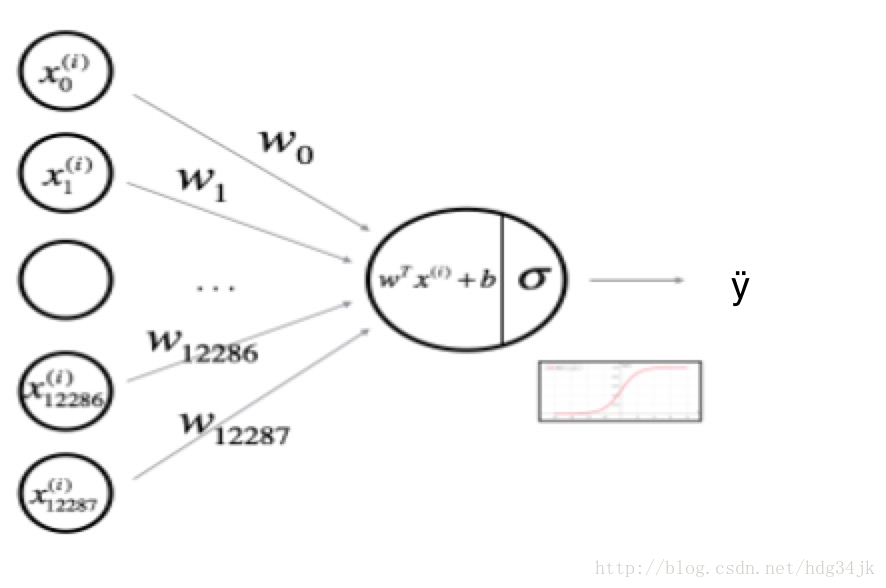吴恩达机器学习第一课便是Logistic Regression,这个算法是一种常见的分类算法,因其使用了logistic函数,由此得名。Logistic Regression可以看成0个隐层的神经网络,学通该算法,对研究神经网络有很大帮助。
1.正向传播
Logistic Regression 算法如下图所示,假设与y的相关的特征为x,通过输入特征x各分量的线性相加,再经非线性函数变换,就可以得到y的估计值,其中w与b是线性叠加中的参数。

将以上过程写成如下公式:

其中σ是激活函数,稍候将会介绍三种常见的激活函数。
接下来将比较估计值与y之间的差距,这个差距通常叫做损失函数,然后最小化损失函数就可以达到训练模型的效果。通常损失函数有以下两种:

对于第一种损失函数,在Logistic Regression中并不常用,因为在优化参数时,优化问题通常会变成非凸问题,非凸问题会有多个极小点,导致陷入局部最优解。
第二种损失函数比较常用,下图解释了为何优化该损失函数达到训练模型的目的,文章最后将会介绍该损失函数的推导过程。

训练模型时通常会有多个样本,需要对所有样本的损失函数求平均,以代表训练集的损失,通常将这种损失称为成本函数:

2.反向传播
以上过程称为Logistic Regression 正向传播过程,下面将介绍如何利用梯度下降法反向传播。反向传播就是通过梯度下降最小化成本函数,首先求解梯度(中间过程略去):

求出梯度后,就可以更新参数了:

其中α是学习步长
最后将正向反向过程向量化,利用矩阵计算加快计算速度。
正向传播过程:

反向传播过程:

不断迭代正向反向传播,就可以得到最优的训练参数。
3.常用激活函数:
三种常见激活函数及其导数如下:


目前神经网络中隐层多使用ReLU函数,因为对于z>0,它的梯度都是相同的,梯度不会随着z变大或变小而变小,从而导致收敛速度变慢。Python中可以这样实现ReLU函数np.maximum(z,0),其导数为(z>0).
4.损失函数推导过程
对于二类分类问题,y只有0与两种取值,假设估计值是输入为x,输出为1的概率,则如下关系成立:

定义p(y/x)为如下形式:

为方便计算,两边取对数,则得到如下公式:

上面的负号是因为,我们希望概率越大越好,而损失函数越小越好,因此概率与损失函数差一个负号。对于多个样本而言的成本函数,可以使用最大释然估计求得:

除以m来控制成本函数的缩放,并加负号得到成本函数:

5.Pyton源码
用Python将以上过程实现,Python源码如下:
import numpy as np
import h5py
import matplotlib.pyplot as plt
import matplotlib
import scipy
from PIL import Image
from scipy import ndimage
from lr_utils import load_dataset
%matplotlib inline
train_set_x_orig, train_set_y, test_set_x_orig, test_set_y, classes = load_dataset()
m_train = np.shape(train_set_x_orig)[0]
m_test = np.shape(test_set_x_orig)[0]
num_px = np.shape(test_set_x_orig)[1]
train_set_x_flatten = train_set_x_orig.reshape(m_train, -1).T
test_set_x_flatten = test_set_x_orig.reshape(m_test,-1).T
n_train = np.shape(train_set_x_flatten)[0]
train_set_x = train_set_x_flatten / 255.
test_set_x = test_set_x_flatten / 255.
def sigmoid(z):
s = 1/(1 + np.exp(-z))
return s
def initialize_with_zeros(dim):
w = np.zeros((dim, 1))
b = 0
assert(w.shape == (dim, 1))
assert (isinstance(b, float) or isinstance(b, int))
return w, b
def initialize_with_zeros(dim):
w = np.zeros((dim, 1))
b = 0
assert(w.shape == (dim, 1))
assert (isinstance(b, float) or isinstance(b, int))
return w, b
def optimize(w, b, X, Y, num_iterations, learning_rate, print_cost = False):
costs = []
for i in range(num_iterations):
grads, cost = propagate(w, b, X, Y)
dw = grads["dw"]
db = grads["db"]
w = w - learning_rate * dw
b = b - learning_rate * db
if i % 100 == 0:
costs.append(cost)
if print_cost and i % 100 == 0:
print ("cost after iteration %i: %f" %(i, cost))
params = {"w":w,
"b":b}
grades = {"dw":dw,
"db":db}
return params, grads, costs
def predict(w, b, X):
m = X.shape[1]
y_prediction = np.zeros((1, m))
w = w.reshape(X.shape[0], 1)
z = np.dot(w.T, X) + b
A = sigmoid(z)
print "A shape" + str(A.shape)
for i in range(m):
if A[0, i] <= 0.5:
y_prediction[0, i] = 0
else:
y_prediction[0, i] = 1
assert(y_prediction.shape == (1, m))
return y_prediction
def model(x_train, y_train, x_test, y_test, num_iterations = 2000, learning_rate = 0.5, print_cost = False):
n = x_train.shape[0]
print n
w, b = initialize_with_zeros(n)
params, grads, costs = optimize(w, b, x_train, y_train, num_iterations, learning_rate, print_cost)
w = params["w"]
b = params["b"]
y_train_predict = predict(w, b, x_train)
y_test_predict = predict(w, b, x_test)
print "train accuracy:{} %".format(100 - np.mean(np.abs(y_train_predict - y_train)) * 100)
print("test accuracy: {} %".format(100 - np.mean(np.abs(y_test_predict - y_test)) * 100))
d = {"costs":costs,
"y_train_predict":y_train_predict,
"y_test_predict":y_test_predict,
"w":w,
"b":b,
"num_iterations":num_iterations,
"learning_rate":learning_rate}
return d
最后
以上就是高挑烧鹅最近收集整理的关于吴恩达学习—Logistic Regression的全部内容,更多相关吴恩达学习—Logistic内容请搜索靠谱客的其他文章。








发表评论 取消回复